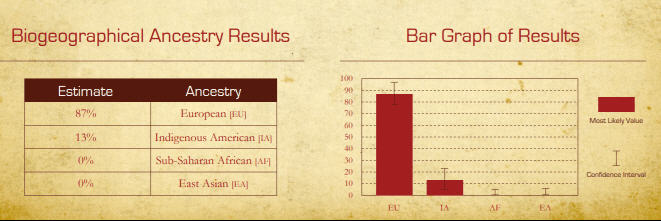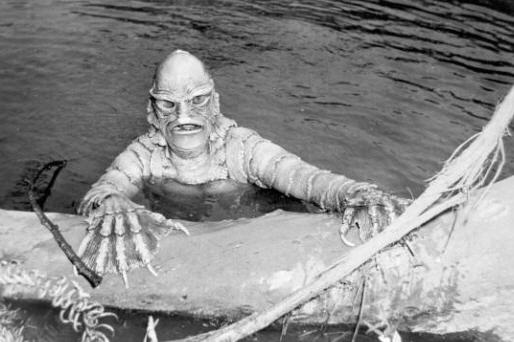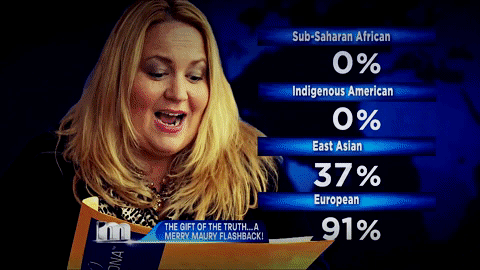AncestrybyDNA is a DNA test introduced in 2002 that provides a high-level breakdown of ancient origins. It is sometimes confused with the offering from AncestryDNA, the testing arm of Ancestry.com.
The AncestrybyDNA kit has changed owners, but it is still on the market in several guises. Its history includes marketing controversy, a lawsuit from Ancestry.com, and a starring role on a dubious TV show.
Don’t make the mistake of purchasing this product thinking that you’ll get a detailed ethnicity report. Read on to learn exactly what you’d get, and avoid being disappointed.
What Happened To AncestrybyDNA?
AncestrybyDNA was launched in 2002 as a DNA test for ancient origins. It is currently owned by DNA Diagnostics Center, and sold under the HomeDNA and DNATruth brands. It should not be confused with the more detailed test from Ancestry.Com.
AncestrybyDNA Enters The Market in 2002
DNAPrint Genomics was founded in 2001 by Dr. Tony Frudakis, a molecular biologist and entrepreneur. The first commercial offering was a genetic product sold to universities and DNA laboratories.
One of the themes of this article is customer confusion due to the similarity of product names with offerings from Ancestry.com. Well, this first product of DNAPrint was called…Truline. Years later, Ancestry would roll out a DNA feature called ThruLines! It’s just as well that DNAPrint discontinued their product and moved on to something else: AncestrybyDNA.
AncestrybyDNA 2.0
DNAPrint rolled out its first consumer DNA test in 2002. They called it AncestrybyDNA 2.0. I don’t think there was a 1.0 before it. That two-point-oh was a cool marketing thing at that time.
AncestrybyDNA Came Before AncestryDNA
It’s important to remember that Ancestry.com didn’t roll out their branded AncestryDNA test until 2012. Ancestry.com rolled out Y-DNA and mtDNA tests in 2002, but not autosomal tests.
Several companies were hitting the consumer DNA market in 2002. The AncestrybyDNA product was one of the first alongside others.
AncestrybyDNA Is A Limited Test Of Ancient Origins
AncestrybyDNA 2.0 was released in 2002. The next version, AncestrybyDNA 2.5, was released in 2004. The major difference was in the number of ancestral markers included in the test.
AncestrybyDNA 2.0 tested 75 markers, while 2.5 tested about 175 markers.
What Are AncestrybyDNA Markers?
Commercial DNA kits do not test every tiny piece of your DNA. That would be far too costly. And besides, it’s not necessary. Most human DNA is identical due to being…human.
Instead, the DNA labs choose a set of positions that are known to vary across our species. These are usually known as SNPs, but AncestrybyDNA refers to them as Markers.
This comparison chart shows the counts of markers currently tested by the major companies. Use the “autosomal” row to compare with AncestrybyDNA. The big guns include Ancestry.com, 23andMe, FamilyTreeDNA, and LivingDNA. They all test over 600 thousand markers.
Wait, 600K versus a measly 175 by AncestrybyDNA? How could AncestrybyDNA even work?
Well, their tests were for a different set of insights than those provided by the others. The corporate owners just didn’t explain that very well – by accident or design.
What Does AncestrybyDNA Tell You?
The small number of markers used by AncestrybyDNA are targeting distinctions at an ancient continental level. Think of the first migrations out of Africa. The tests look for markers from four population groups:
- East Asian
- Indo-European
- Native American
- Sub-Saharan African
The DNA test provides a breakdown percentage against these categories.
The AncestrybyDNA Founder Explains The Accuracy Of His Test
I’ve pulled together some comments made by Dr Tony Frudakis in 2016 on a blog article by Roberta Estes. I’ll be coming back to this article later. Frudakis founded the company that launched this DNA test.
- “the test is looking at a deeper slice of the human family tree”
- “it is looking at the older “roots” from when populations had just expanded out of Africa”
- “it was designed to report on more ancient ancestry, not recent ethnic levels of ancestry”
This is a valid but very broad analysis. And many people aren’t particularly interested in such distant insights. They turn to DNA tests for clues to more recent genetic heritage.
Frudakis goes on to comment about the autosomal DNA tests with a much larger number of markers. These include AncestryDNA, 23andMe, MyHeritage, and FamilyTreeDNA.
How Accurate Is AncestrybyDNA?
Are you still wondering whether to buy an AncestrybyDNA test for insights into ethnicity and/or your family tree? Here’s your answer:
Most people are interested in finer distinctions… the current crop of large marker sets and methods are best suited for that.
Dr Tony Frudakis commenting on the DNA-Explained blog
What Do The AncestrybyDNA Test Results Look Like?
An AncestrybyDNA test gives you a certificate with percentages of your DNA estimates under four huge populations. This is what one looks like:

This person is given 87% European ancestry and 13% Indigenous American.
And that’s pretty much all you get. Before you think of purchasing this product from the current vendors, take a look at the features offered by the major consumer DNA companies.
Both AncestryDNA and MyHeritage pinpointed my Irish ethnicity to the small county where all my maternal great-grandparents were born. They don’t do so well on my African ethnicity – but you get far more details about European heritage.
I’ve got a full review of how to interpret AncestryDNA ethnicity results. And another on MyHeritage Genetic Groups.
In addition, the major companies show you possibly thousands of DNA relatives to help your family research. Some provide family tree features, and some provide historical archives.
AncestrybyDNA’s Founding Company Went Out Of Business
In the early 2000s, DNAPrint and Frudakis struggled to grow to profitable levels. An SEC filing in 2004 points to their difficulties:
“Although we have been in existence for a number of years, management’s efforts to develop our business have not yet resulted in the generation of significant revenues.”
DNAPrint Genomics never made it. And I can point to why. They backed the wrong horse with their small number of markers. This is what they had to say about their competition:
“Other companies … are currently screening hundreds of thousands to millions of markers across the genome. This process is not commercially viable for many markets, due to cost.”
Advancements in the hardware of DNA testing proved this prediction to be wrong. Their competitors were raising more money for bigger and better chip technologies. DNAPrint Genomics went into liquidation in 2009.
But that wasn’t the end of AncestrybyDNA. The test and the brand was bought by DNA Diagnostics Center.
AncestrybyDNA Is Still In Business – And Owned By DNA Diagnostics Center (DDC)
DNA Diagnostics Center is an Ohio-based company. It originally specialized in paternity tests. The audience for AncestrybyDNA was a new departure.
Here’s the announcement from 2009:
“Through an exclusive worldwide licensing agreement with DNA Print Genomics, DNA Diagnostics Center (DDC) is launching a test that can identify 176 unique Ancestral Informative Markers in human DNA.“
There’s that tiny number of markers again. So, would DDC make it clear that their test was not suitable for building your family tree back a few centuries? Umm, not really.
“This test can give anyone a quick glimpse of who they are, based on the generations that came before them. It’s a great test for anyone curious about their family history.”
Yes, it’s a glimpse into generations that came before. A long long time before.
Confusion, Controversy, and Ancestry.COM
Ancestry.com started its move into autosomal DNA tests in 2011 when it signed up a few thousand pre-launch customers. There was a big buzz about this in genealogical circles. They started selling their tests in May 2012.
Ancestry.com branded their tests as “AncestryDNA”. That’s when the trouble started.
The rival AncestrybyDNA test got a big marketing push through an interesting promotion. CeCe Moore captured the marketing offer at the time. It was headlined as “AncestryDNA” – yeah, missing the crucial “by”.
CeCe Moore mentioned “the misleading way it was presented” to the General Manager of AncestryDNA.
Shortly afterward, the promotional copy changed the headline to “AncestrybyDNA”. They had no choice, it was a clear copyright infringement.
The comments under the blog article make it clear that many people purchased the AncestrybyDNA test thinking they were getting the AncestryDNA version.
Personally, I put most of the blame on Ancestry.com. They chose a moniker that was very close to a small brand that had been around for ten years.
Having said that, it was a very dodgy move by whoever was in charge of the AncestrybyDNA marketing campaign. And the problem kept trucking on. People continued to comment over the next few years on this same article. Here’s a very frustrated AncestrybyDNA customer in 2016:
It’s TOTAL CRAP! YOU ONLY GET A FREAKING CERTIFICATE! YOU DON’T GET ANY INFORMATION. I KNOW I’M FROM AMERICA EUROPE AND AFRICA. BIG DEAL.
Comment on CeCe Moore’s Blog (2016)
I’ve heard that if you comment in caps, people will read it harder.
And more recently in 2018:
I purchased AncestrybyDNA through Groupon, not realizing that it was a knockoff.
Comment on CeCe Moore’s Blog (2018)
Ancestry.Com Loses Court Case
Ancestry went to court to try to force DNA Diagnostics Center from using “ancestry” as part of the brand name of their test.
The Ohio court found in favor of DDC. It reasonably pointed out that the AncestrybyDNA brand was started in 2002, and there wasn’t a problem until Ancestry.com rolled out its AncestryDNA test service.
AncestrybyDNA and the HomeDNA Brand
DNA Diagnostic Center is still selling AncestrybyDNA in several different guises. HomeDNA is one of the two prominent brands. The other is DNATruth, which I’ll get to later.
The HomeDNA brand has several different DNA kits. The old AncestrybyDNA is available as a “starter” kit.
By the way – any links here are certainly not affiliate links! I am not recommending this product – I’m just providing the links so you’ll recognize the old technology if you stumble across it.
I read through the marketing material on their website, and I don’t have a problem with how it’s being currently presented. It’s clear that only four populations are identified: Europe, Native American, East Asian, and Sub-Saharan Africa.
But wait, there’s more! This kit will also tell you the geographical regions where these four populations are prevalent in current times. What has that got to do with your specific DNA test? Well, nothing. They could have published that report on the website for all their customers.
So that’s it. And it costs about $70!
Here is my strong recommendation: do not bother purchasing this product. Buy any of AncestryDNA, 23andMe, MyHeritage, FamilyTreeDNA, or LivingDNA.
HomeDNA and GPS Origins
DNA Diagnostic Center offers different DNA kits under the HomeDNA brand. The “GPS Origins” test uses a far increased volume of markers, similar or greater to AncestryDNA or 23andMe.
GPS Origins results make a big play out of providing results as pins on a global map. Some customers find that their pins turn up in odd places. I had a good laugh at this FAQ header (straight from their website, I swear!):
What if my location point is sitting over a body of water?
Ooh! My thoughts turned to ancestors like this:

Or maybe this 20th great grandfather in fine fettle:

But disappointingly, the answer is more prosaic.
Occasionally, your genetic location may reside over a pond or river, but don’t be alarmed, it doesn’t mean your DNA has originated in the water but rather that nowadays the river is running very close to the region where your DNA originated.
Comforting words from DNA Diagnostic Center
DNA Truth, The Maury Show, and AncestrybyDNA
I mentioned that I had few reservations about the current marketing I’ve seen for AncestrybyDNA under the HomeDNA brand.
I can’t say the same for an alternative branding. This arose from the choice of AncestrybyDNA for a tabloid-style television show. The Maury Show ran a recurring segment where they invited people to take a DNA test to reveal their “shocking” ethnicity results.
For example, one lady lamented that her Irish/Italian heritage was disappointingly boring. But then she opened her AncestrybyDNA certificate. She got 91% European and 9% East Asian.

“I’m Asian! I’m so excited that I’m Asian. I have flavor now! I have flavor!”
This is ridiculous. I hope she’s an actress pretending to believe what she’s yelling. But who knows?
The Maury Show refers to DNATruth.com as the source of the DNA tests. The website is still on the go, with a classy tag line of “DNA Testing for Ancestry: As Seen on the Maury Show”.
The website is unsecured. It has that tacky look that suggests your credit card would end up on the dark market. But it’s part of the DNA Diagnostics Center.
The Founder Reflects On What Became Of AncestrybyDNA
When I was researching this article, I was looking for reactions from people who had actually purchased an AncestrybyDNA test. And they were easy to find – many were commenting and complaining on genealogy blogs about not getting what they expected.
But I was surprised to see a familiar name pop up amongst some comments on the DNA-Explained blog. Roberta Estes wrote a scathing article about AncestrybyDNA in 2014. She offered ten things to do with your certificate – the list included lining the bottom of the birdcage or using it as scratch paper.
Two years later (!), the founder of the AncestrybyDNA test rolled up his sleeves and wrote a kind of rebuttal. I’ve already covered the central point from Dr. Tony Frudakis: that the test was intended to give insight into ancient ancestry.
When Frudakis was commenting in 2016, he was long gone from involvement with the AncestrybyDNA test. But he wasn’t happy that people were purchasing the test thinking they were getting an ethnicity breakdown.
“I do agree that the test should NEVER be marketed as suitable for persons seeking detailed ethnic information, and I am very unhappy to hear that this is the case.”
And I’ll leave him the last word:
“The typical customer we found is a typically “white” lady who wants to substantiate her Native or Indigenous American ancestry and couldn’t care less about her connection to other Central Asian diaspora. Though it is too bad that these people buy AncestrybyDNA not understanding they are not buying what they want (and this still somehow needs to be corrected), it does not mean there is no value to deeper level testing.“
I was wondering where it went…seeing as I paid for it and all…Thanks for the clarification. Also Dr. Tony Frudakis is a self-righteous donkey.
I purchased AncestrybyDNA and thought I would receive a greater breakdown of my lineage. At first, I was disappointed. I love my certificate that is not glutted with 30 or 40 different % from various places throughout the world.
I have worn my certificate out and would love to print up a fresh new copy. I want to go deeper on the Indigenous American %, but until recently not willing to pay the $300. I am able to focus on the genealogy that is most important to me, at this time.